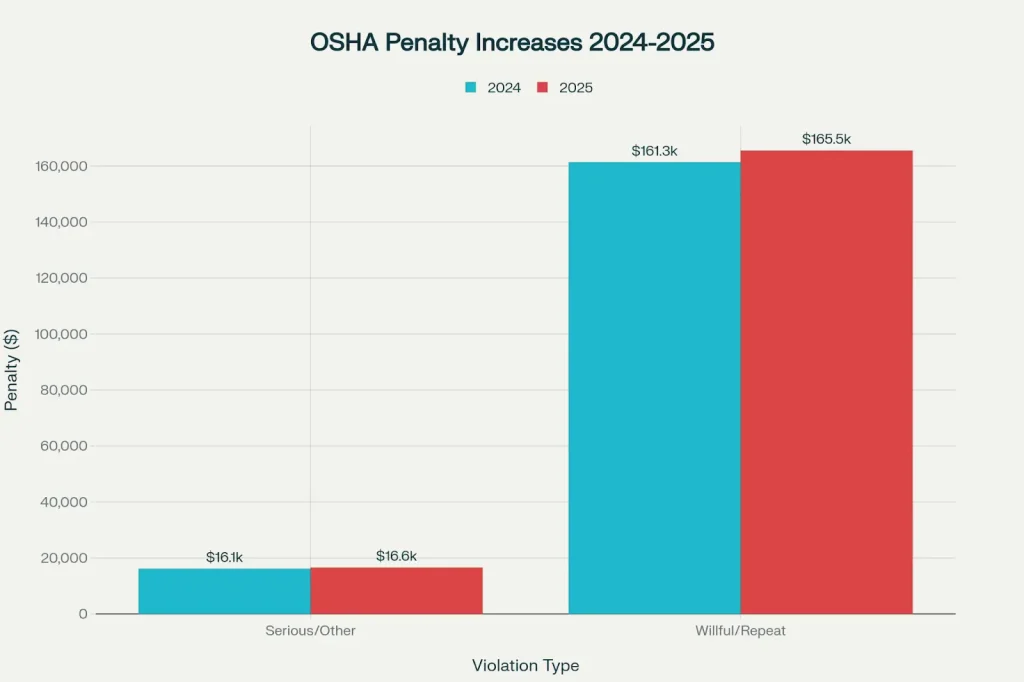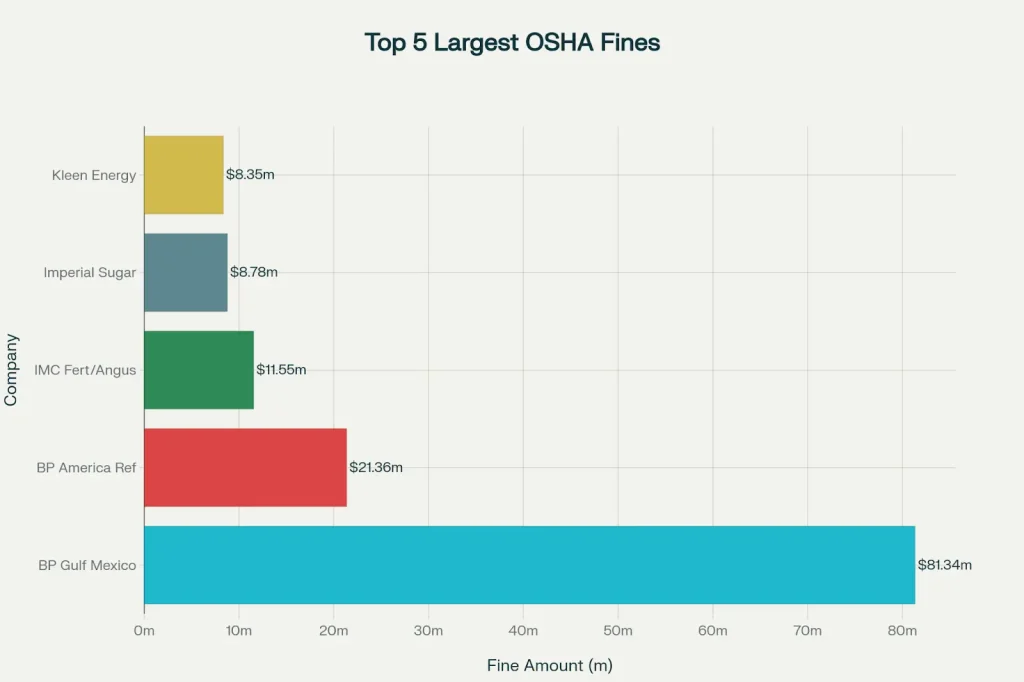OSHA Fines & Penalties Statistics
OSHA’s penalty system is one of the strongest tools the agency uses to ensure workplace safety compliance. In 2025, maximum fines for willful or repeat violations can reach $165,514 per citation, underscoring just how costly noncompliance can be. These penalties are designed not only to deter unsafe practices but also to encourage employers to invest in proactive safety programs.
At the same time, OSHA allows for adjustments, such as reductions based on company size, good faith efforts, or past compliance history, to balance fairness with accountability. Understanding how penalties are structured, where the largest fines occur, and which industries face the highest risks provides crucial insight for businesses aiming to stay compliant and protect their workforce.
2025 Penalty Structure and Increases
On January 15, 2025, OSHA applied its annual penalty adjustments as required by the Federal Civil Penalties Inflation Adjustment Act. This year’s update raised fines by 2.6% across all violation categories, affecting penalties for serious, other-than-serious, willful, repeat, and failure-to-abate violations.
While the percentage may seem small, the financial impact for employers can be substantial. A single citation in 2025 could now cost tens of thousands of dollars, and willful or repeat violations can exceed $165,000 per violation. For many businesses, especially small and mid-sized companies, these increases represent a significant compliance risk.
The steady annual rise in OSHA penalties underscores the agency’s approach: keeping fines aligned with inflation while ensuring they remain a meaningful deterrent. Employers who fail to prioritize safety may face higher costs year after year, reinforcing the importance of proactive compliance programs.

OSHA Maximum Penalties: 2024 vs 2025 Comparison
OSHA’s penalties are not one-size-fits-all; they depend on the nature and severity of the violation. In 2025, the agency raised maximum penalties to reflect annual inflation adjustments and to reinforce its commitment to stronger enforcement. Here’s how the penalty landscape shifted from 2024 to 2025:
Serious & Other-Than-Serious Violations
In 2025, the maximum penalty for serious and other-than-serious violations increased from $16,131 to $16,550, a rise of $419 (about 2.6%). These violations cover hazards that could cause significant harm or even death, though they are not tied to intentional disregard of safety rules. Employers may qualify for reductions based on company size, good faith efforts, or compliance history, but the financial risk is still considerable.
Willful & Repeat Violations
The steepest fines apply to willful and repeat violations, which rose from $161,323 in 2024 to $165,514 in 2025, an increase of $4,191. A willful violation reflects a knowing disregard of OSHA standards or plain indifference to worker safety. A repeat violation is issued when an employer is cited for the same or a similar hazard within five years. Beyond the financial burden, these violations often damage an employer’s reputation and can trigger heightened scrutiny from regulators.
Failure-to-Abate Violations
Failure-to-abate penalties also climbed, moving from $16,131 per day in 2024 to $16,550 per day in 2025. These fines accrue daily after the correction deadline passes, creating virtually unlimited exposure for employers who delay compliance. To put this in perspective, a 30-day delay could add nearly $500,000 in penalties on top of the original citation, making timely abatement a critical priority.
Penalty Reduction Factors
OSHA’s penalty system isn’t one-size-fits-all; several reduction factors can lower fines for employers who demonstrate responsibility and commitment to safety. These adjustments consider company size, safety programs, compliance history, and even immediate hazard correction.
Company Size Reductions
In 2025, OSHA expanded its small business relief by raising the threshold for maximum reductions. Now, businesses with 25 or fewer employees can qualify for up to a 70% reduction in penalties, compared to the previous limit of 10 employees.
This change reflects OSHA’s recognition that smaller companies often lack the same financial and administrative resources as larger corporations when it comes to implementing comprehensive safety programs.
Mid-sized firms receive smaller reductions, 30% for companies with 26–100 employees and 10% for those with 101–250 employees, while large employers with over 250 workers typically receive no size-based relief. By structuring penalty reductions this way, OSHA balances accountability with fairness, ensuring smaller businesses remain compliant without being disproportionately burdened.
Good Faith and History Adjustments
OSHA provides up to a 25% penalty reduction for employers who demonstrate good faith efforts toward maintaining a safe workplace. This adjustment isn’t automatic; it requires clear, documented evidence that the company is actively managing safety.
Examples include maintaining written safety and health programs, conducting regular employee training, ensuring management visibly supports safety initiatives, and putting effective hazard controls into practice.
These measures show that the employer isn’t just reacting to violations but is instead taking a proactive, prevention-first approach. Beyond lowering penalties, good faith reductions signal OSHA’s recognition of companies that strive to integrate safety into their daily operations, even if issues occasionally arise. The emphasis is on fostering a culture of responsibility where compliance goes hand-in-hand with worker protection.
Record-Breaking Fines and Major Cases
Over the years, OSHA has issued several record-breaking fines that highlight the severe consequences of ignoring workplace safety. These cases not only involved massive financial penalties but also drew national attention to the importance of compliance and accountability.

Top 5 Largest OSHA Fines in History (Millions of Dollars)
These record-setting fines reveal OSHA’s toughest enforcement actions against companies that failed to protect their workers. Each case underscores how severe penalties often follow catastrophic incidents or repeated noncompliance.
BP Products North America – $81.3 Million
Following the 2005 Texas City Refinery explosion, which killed 15 workers and injured more than 170, BP was fined for multiple willful violations. This remains one of the largest penalties in OSHA’s history, underscoring the dangers of systemic safety failures.
BP Products North America – $50.6 Million
In 2009, BP faced another major fine for failing to correct hazards identified after the Texas City disaster. OSHA cited the company for failure-to-abate violations, demonstrating its willingness to impose steep penalties for repeat noncompliance.
Imperial Sugar Company – $8.7 Million
After a 2008 explosion at a sugar refinery in Georgia that killed 14 workers, OSHA issued more than 100 citations, including willful violations. This case highlighted the devastating consequences of combustible dust hazards.
IMC Fertilizer – $11.6 Million
In 1997, a Florida fertilizer plant explosion that killed four workers led to one of OSHA’s largest fines at the time. The case served as a turning point in how OSHA handled process safety management violations.
Walmart Stores Inc. – $7.0 Million (Settlement)
Walmart agreed to a settlement in 2013 to resolve long-standing violations related to blocked exits, inadequate training, and poor safety practices across multiple stores. Though not linked to a single incident, the scope of violations across its retail operations made it one of the most significant corporate OSHA penalties.
Criminal Penalties and Enhanced Enforcement
While most OSHA violations result in civil fines, the most serious cases can trigger criminal penalties. These prosecutions remain rare but carry severe consequences, including hefty corporate fines and potential prison time for individuals.
When OSHA Violations Become Criminal
Most OSHA cases are handled through civil penalties, but violations that cause a worker’s death can escalate into criminal charges. Under the OSH Act, individuals may face up to six months in federal prison and fines of $250,000, while companies can be fined up to $500,000. These cases often involve willful neglect of safety standards, making them the harshest form of OSHA enforcement.
Limited Criminal Prosecutions
Although the law allows for criminal prosecution, it is rarely applied. Since OSHA’s inception more than 50 years ago, only 151 cases have been referred to the Department of Justice. Of these, roughly 67% were declined for prosecution, and just eight cases resulted in company officials serving prison time. The rarity highlights the difficulty of meeting the legal burden of proof in workplace safety crimes.
Enhanced DOJ Coordination
In 2024, OSHA and the Department of Justice strengthened their partnership to pursue criminal referrals more aggressively. The initiative targets repeat offenders and employers whose willful negligence causes fatalities. This collaboration reflects a significant shift toward holding both individuals and corporations accountable, particularly in industries with a history of serious safety violations.
State Plan Variations
While federal OSHA sets the baseline for workplace safety penalties, 22 states and territories operate their own OSHA-approved programs. These plans must be “at least as effective” as federal OSHA, but many adopt stricter fines and unique penalty structures, often resulting in significantly higher penalties and tougher enforcement standards.
California’s Cal/OSHA
California consistently leads with tougher penalties than federal OSHA. Serious violations can bring fines of up to $25,000, while willful violations may reach $162,851. Cal/OSHA’s approach reflects the state’s aggressive enforcement stance, particularly in high-risk industries like construction and agriculture.
Oregon OSHA
Oregon takes a different approach with a detailed penalty matrix that weighs both the probability and severity of harm. Willful violations linked to high-severity or death-rated hazards can reach $105,440. The state also imposes enhanced penalties when violations directly contribute to worker fatalities, reinforcing accountability for serious safety failures.
Industry-Specific Penalty Patterns
OSHA penalty trends reveal that certain industries face disproportionately high fines due to recurring hazards and compliance gaps. Construction routinely tops the list with fall protection and trench cave-in violations, while oil and gas companies face catastrophic penalties tied to large-scale incidents. Even “low-risk” sectors like retail and warehousing often accumulate hefty fines through persistent, repeated violations of basic safety requirements.
Construction Industry
The construction sector consistently faces some of the highest OSHA penalties due to the inherently hazardous nature of the work. Common violations include fall protection failures, which remain OSHA’s most frequently cited standard, and trench safety issues, where collapses can result in multiple fatalities.
In Q4 2024 alone, penalties for major construction cases ranged from $100,000 to over $330,000. The industry is high-risk because hazards are immediate and often life-threatening, and violations are visible during site inspections. OSHA continues to prioritize construction enforcement, making compliance in this sector especially critical.
Oil and Gas Sector
Oil and gas operations carry unique risks tied to catastrophic process safety failures and large-scale environmental hazards. A single incident, such as an explosion or uncontrolled release, can result in massive fines and long-term regulatory scrutiny. The sector has seen record-setting penalties, with BP’s historic fines serving as a prime example of the consequences of safety breakdowns.
OSHA emphasizes process safety management (PSM) in this industry, targeting systemic failures that can cause widespread harm. Companies in this sector face not only financial penalties but also reputational and legal challenges that extend far beyond OSHA citations.
Retail and Warehousing
Although often seen as “low-risk,” retail and warehousing have become focal points for OSHA due to persistent and repeated violations. A prominent example is Dollar General, which has accumulated millions in fines for issues such as blocked exits, unsafe storage, and inadequate emergency preparedness.
These hazards may not seem as catastrophic as those in construction or oil and gas, but the cumulative effect of repeated violations leads to significant penalties. OSHA views this pattern as a disregard for worker safety, reinforcing that even low-risk industries cannot afford to neglect compliance.
2025 Enforcement Trends
OSHA’s enforcement strategy in 2025 reflects both tougher penalties and smarter targeting of unsafe employers. From inflation-based fine increases to technology-driven inspections, these trends highlight how the agency is balancing deterrence with fairness to drive lasting workplace safety improvements.
Inflation-Adjusted Penalties
Every January, OSHA updates its penalties to account for inflation, ensuring fines remain a strong deterrent. In 2025, maximum penalties increased by 2.6%, a continuation of this annual adjustment. While the percentage may seem small, it can translate to thousands of dollars for a single citation. This trend shows OSHA’s commitment to keeping penalties financially impactful.
Focus on Small Businesses
OSHA has expanded penalty reductions for smaller employers in 2025, acknowledging that limited resources can make compliance more challenging. Businesses with 25 or fewer workers now qualify for up to 70% penalty relief, a significant increase from previous years. This trend signals an effort to balance fairness with enforcement, encouraging safety without overwhelming small firms.
Targeting Repeat Violators
Employers with a history of violations are firmly in OSHA’s crosshairs for 2025. Through the Severe Violator Enforcement Program (SVEP), repeat offenders face harsher scrutiny and elevated penalties. This trend reflects OSHA’s strategy of focusing on employers who repeatedly ignore safety standards. It’s a clear warning that persistence in unsafe practices will result in escalating consequences.
Technology-Enhanced Investigations
OSHA is increasingly using digital tools and data analytics to direct enforcement where it’s most needed. By analyzing patterns, the agency can identify high-risk industries and employers with recurring issues more effectively. This approach allows inspectors to be more strategic, ensuring resources are deployed where violations are most likely. For employers, this means compliance gaps are harder to hide.
Balancing Deterrence with Fairness
OSHA’s penalty system continues to walk a fine line between punishment and incentive. On one hand, fines are steep enough to deter unsafe practices; on the other, reductions are available for employers that demonstrate good faith, immediate corrections, or strong safety programs. This balance is designed to reward proactive compliance while reserving the harshest consequences for willful or repeat offenders.
Wrap Up
OSHA’s 2025 penalty structure shows a clear shift toward stronger enforcement, higher fines, and smarter oversight. While reductions reward good faith and compliance, repeat offenders and willful violators face steeper consequences than ever. For employers, the message is simple—invest in safety now or risk paying far more later.

